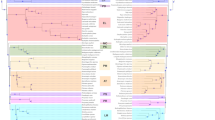Summary and conclusions
-
1.
The chromosome numbers of 51Miridae and nineNabidae (Hemiptera-Heteroptera, Cimicoidea) are given.
-
2.
InMiridae, Deraeocorinae, Bryocorinae andMirinae have a type 2n=34 and Phylinae 2n=32. Dicyphinae has 2n=48 and Orthotylinae 2n=24. The basic mirid caryotype is 32A+X+Y.
-
3.
The caryotype ofDicyphinae supports the view that the group warrants subfamily status.
-
4.
Phylus melanocephalus (2n=18) is unique amongst the mirids examined and could perhaps be retaining a primitive pro-mirid chromosome number.
-
5.
InNabidae, Nabinae have a type 2n=18.
-
6.
The species pairNabis rugosus andN. ericetorum are characterised by the same kind of deviation from family caryotype.
-
7.
Himacerus mirmecoides has double the family complement of autosomes.
-
8.
The basic cimicoid caryotype is, it is suggested, 2n=16A+ X+Y.
Similar content being viewed by others
References
Carvalho, J. C. M.: Chaves para os generos de Mirideos do Mundo (Hemiptera). Bol. Mus. para. Emilio Goeldi11 (2), 1–151 (1955).
Carvalho, J. C. M., andD. Lesion: The classification of the BritishMiridae (Hem.), with keys to the genera. Ent. mon. Mag.88, 231–251 (1952).
Knight, H. H.: The plant bugs, orMiridae, of Illinois. Bull. Illinois Nat. Hist. Surv.22 (1), 1–234 (1941).
Kullenberg, B.: Über Morphologie und Funktion des Kopulationsapparates der Capsiden und Nabiden. Zool. Bidr.24, 217–418 (1947).
Leston, D.: Geographical zonation of atypical caryotypes in shieldbugs. Nature (Lond.)178, 933–334 (1956).
- Chromosome number and the systematics ofPentatomomorpha (Hemiptera). Trans. int. Congr. Ent.10 (1957).
Leston, D., J. G. PenderGrast andT. R. E. Southwood: Classification of the terrestrialHeteroptera (Geocorisae) Nature (Lond.)174, 91–92 (1954).
Leston, D., andT. R. E. Southwood: An annotated checklist of the BritishHemiptera-Heteroptera. Trans. Soc. Brit. Ent. (in preparation).
Makino, S.: An atlas of the chromosome numbers in animals. Ames, Iowa: Iowa State College Press 1951.
Schrader, F., andS. Hughes-Schrader: Polyploidy and fragmentation in the chromosomal evolution of various species ofThyanta (Hemiptera). Chromosoma7, 469–496 (1956).
Slack, H. D.: Cytological studies on five families ofHemiptera-Heteroptera. Thesis for degree of Ph. D.: University of Edinburgh 1938 (unpublished).
Slater, J. A.: An investigation of the female genitalia as taxonomio characters in theMiridae (Hemiptera). Iowa State Coll. J. Sci.25, 1–81 (1950).
Wagner, E.: Bemerkungen zum System derMiridae (Hem. Het.). Dtsch. entomol. Z., N. F.2, 230 bis 242 (1955).
White, M. J. D.: Animal cytology and evolution. London: C. U. P. 1954.
Author information
Authors and Affiliations
Rights and permissions
About this article
Cite this article
Leston, D. Cyto-taxonomy of Miridae and Nabidae (Hemiptera). Chromosoma 8, 609–616 (1956). https://doi.org/10.1007/BF01259522
Received:
Issue Date:
DOI: https://doi.org/10.1007/BF01259522




